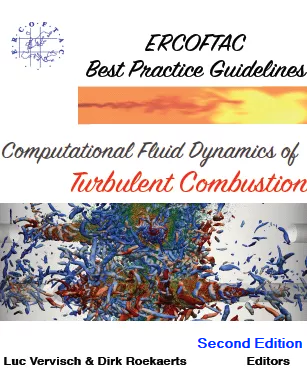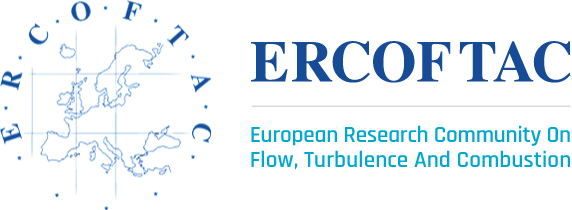ERCOFTAC BPG Book Series
Computational Fluid Dynamics of Turbulent Combustion - Second Edition
Electronic copy to be downloaded from the website
Preface to the second edition:

Since the first edition published in 2015, the interest in numerical modeling of the emission of particulate material formed in flames is continuously growing. Along these lines, this second edition includes an additional Chapter on the modeling of sooting flames. The fundamentals driving the formation and the evolution (nucleation, growth, agglomeration, oxidation) of flowing non-inertial particles are first discussed, before presenting best practices for major soot modeling approaches in CFD of turbulent flames.
Dirk Roekaerts and Luc Vervisch March, 2020.
Overview:
The aim of this Best Practice Guide (BPG) is to provide guidelines to CFD users in a wide range of application areas where combustion is an essential process. Since the first edition published in 2015, the interest in numerical modeling of the emission of particulate material formed in flames is continuously growing. For this reason, this second edition includes an new Chapter on the modeling of sooting flames.
The overall structure of the BPG is as follows:
Chapters 1-3 summarize key issues in turbulent combustion model formulation. Chapter 4 is addressing the validation of modelling using available experimental databases. In the new Chapter 5 the fundamentals driving the formation and the evolution (nucleation, growth, agglomeration, oxidation) of flowing non-inertial particles are discussed, before presenting best practices for major soot modeling approaches in CFD of turbulent flames.Then, two application areas are elaborated in separate chapters: Chapter 6 on Internal Combustion Engines, and Chapter 7 on Gas Turbines. Best practice guidelines by the nature of technology development are always temporary. New insights and approaches will take over after some time. Therefore this BPG ends with a Chapter 8 on Emerging Methods, providing a preview of approaches so far only useful for simulating canonical configurations or requiring further developments.
A comprehensive CFD approach to turbulent combustion modelling relies on appropriate submodels for flow turbulence, chemistry and radiation, and their interactions. In the framework of this BPG, knowledge of turbulent flow modeling is a pre-requisite and only briefly explained. Instead the discussion on models is divided in three parts:turbulence-chemistry interaction (Chapter 1), chemistry (Chapter 2) and radiative heat transfer (Chapter 3). Many of the models introduced in the first three chapters will reappear in the discussion in Chapters 4 to 6 and comments on challenges, advantages and disadvantages are formulated in all chapters.
Those looking for immediate advices to tackle a specific application may want to proceed immediately to the application chapters (IC engines in Chapter 5 and Gas Turbines in Chapter 6) and return to the basic chapters when necessary. But everyone not finding in these chapters an immediate answer to the basic question: ‘What is the best model for my specific application?’ should certainly spend some time on Chapter 4, because it addresses the mandatory preliminary steps that have to be considered to validate a simulation involving any sort of turbulent flames.
Content:
1. Introduction to turbulent combustion modeling
Luc Vervisch and Pascale Domingo - CORIA - CNRS, INSA Rouen, Normandy University, France
1.1 Background and challenges
1.2 Major length and time scales
1.3 Generic scalar balance equation
1.3.1 Eddy viscosity - RANS & LES
1.4 Modeling review
1.4.1 Fixed flame structure
1.4.2 Micro-mixing modeling
1.4.3 LES-specialized turbulent combustion modeling
1.5 Conclusion
2. Combustion Chemistry
Ulrich Maas - Karlsruhe Institute of Technology, Germany
2.1 Introduction
2.2 Chemical Source Terms
2.2.1 Need for source terms
2.2.2 Rate laws
2.2.3 Rate laws for elementary reactions
2.3 Combustion Kinetics
2.3.1 Formation of Radicals
2.3.2 Fuel oxidation
2.4 Time Scales of Chemical Kinetics
2.5 Detailed Reaction Mechanisms
2.5.1 State of the art
2.5.2 Different strategies for the mechanism development
2.5.3 Different strategies for optimization
2.5.4 Available Detailed Mechanisms
2.5.5 Implementation
2.5.6 General remarks
2.6 Skeleton Mechanisms
2.6.1 Construction of skeleton mechanisms based on intuition
2.6.2 Mathematical analysis
2.6.3 General remarks
2.6.4 Adaptive Chemistry
2.7 Principles of Reduced Kinetic Models
2.8 Knowledge Based Model Reduction
2.8.1 Methods for Analysis
2.8.2 Implementation of steady state and partial equilibrium assumptions
2.9 Manifold Methods
2.9.1 Principles of Manifold Methods
2.9.2 Identification of Low-Dimensional Manifolds
2.10 Global Mechanisms
2.11 Tabulation Strategies
2.12 Implementation of reduced schemes
2.13 Conclusions
3. Thermal Radiation
Pedro J. Coelho - Universidade de Lisboa, Lisboa, Portugal
Marco Mancini - Technische Universität Clausthal, Germany
Dirk J.E.M. Roekaerts - Delft University of Technology, The Netherlands
3.1 Radiative Heat Transfer in Combustion Systems
3.1.1 Radiative transfer equation
3.1.2 Absorptivity, emissivity, transmissivity
3.1.3 Radiative heat flux and radiative source term
3.2 Solution Methods for Thermal Radiation
3.2.1 Optically thin approximation
3.2.2 Optically thick approximation
3.2.3 Spherical harmonics method
3.2.4 Discrete transfer method (DTM)
3.2.5 Discrete ordinates method (DOM)
3.2.6 Finite volume method (FVM)
3.2.7 Monte Carlo method
3.2.8 Other solution methods
3.3 Radiative Properties of Gases
3.3.1 Line-by-line model
3.3.2 Narrow band models
3.3.3 Wide band models
3.3.4 Correlated k-distribution method
3.3.5 Global models
3.3.6 Total gas radiative properties
3.3.7 Other gas property models
3.4 Radiative Properties of Particles
3.4.1 Radiative properties of soot particles
3.4.2 Radiative properties of coal particles
3.4.3 Radiative properties of biomass particles
3.4.4 Radiative properties of droplets
3.4.5 Radiative properties of porous media
3.5 Turbulence-Radiation Interaction
3.6 Computational Implementation of Radiation Models
3.7 Summary of Guidelines
3.7.1 Selection of the radiation model and RTE solution method
3.7.2 Selection of the radiative properties model
3.7.3 Computational implementation
3.8 Examples of Validation Studies and Applications
3.8.1 Example 1: Comparison of radiative transfer models
3.8.2 Example 2: Comparison of spectral models
3.8.3 Example 3: Application to a laboratory combustor (BERL furnace)
3.8.4 Example 4: Application to MILD combustion
4. RANS and LES validation
Friedrich Dinkelacker - Leibniz Universität Hannover, Germany Andreas Kempf - Universität Duisburg-Essen,Germany
Guido Kuenne - Technische Universität Darmstadt, Germany
Michael Pfitzner - Universität der Bundeswehr München, Germany
4.1 Reacting versus non-reacting CFD validation
4.1.1 Why validate a CFD code?
4.1.2 Validation of Combustion CFD codes
4.1.3 Steps in a CCFD validation process
4.1.4 Analysis of CCFD validation simulations
4.1.5 Differences in CCFD validation for RANS and LES codes
4.2 Non premixed validation flames
4.2.1 Combustion physics
4.2.2 Overview of some available validation flames
4.2.3 Piloted Jet Flames
4.2.4 Bluff-Body Flame
4.2.5 Conclusions and best practice guidelines non premixed flames
4.3 Fully premixed validation flames
4.3.1 Combustion Physics and Remarks for Usability as Validation Flames
4.3.2 Premixed Turbulent Validation Flames
4.3.3 Atmospheric 48 mm Bunsen Flames from Erlangen
4.3.4 High Pressure Bunsen Flames from Orléans
4.3.5 Large Sudden Expansion Combustor from PSI
4.3.6 Conclusions and best practice guidelines for premixed turbulent flames
4.4 Partially premixed / stratified validation flames
4.4.1 Combustion physics
4.4.2 Overview over validation flames
4.4.3 Swirl burner (TECFLAM)
4.4.4 Stratified burner
4.4.5 Conclusions and best practice guidelines for partially premixed flames
4.5 General conclusions
5. Sooting flames
Stelios Rigopoulos - Imperial College London, UK
5.1 Introduction
5.1.1 Fundamental processes in soot formation
5.2 Soot models
5.2.1 Taxonomy and historical overview of soot models
5.2.2 Semi-empirical non-precursor models
5.2.3 PAH formation
5.2.4 Nucleation
5.2.5 Surface growth and oxidation
5.3 Soot aerosol dynamics
5.3.1 The particle size distribution
5.3.2 The Population Balance Equation (PBE)
5.4 Solution of the PBE
5.4.1 Method of moments and variants
5.4.2 Discretisation methods
5.5 Coupling of soot models with flow
5.6 Turbulent combustion and soot
5.6.1 Closure problem for soot in turbulent flow
5.6.2 Fundamentals of turbulence-soot interaction
5.6.3 Modelling of turbulence-soot interaction - monodisperse and moment-based models
5.6.4 Modelling of turbulence-soot interaction - discretised PBE
5.7 Choice of models
5.7.1 Choice of combustion mechanism for soot modelling
5.7.2 Suggested configurations
6. Internal Combustion Engine
Amsini Sadiki, Francesca di Mare and Kaushal Nishad - Darmstadt University of Technology, Germany
Peter Keller, Stefan Buhl, Frank Hartmannand and Christian Hasse - TU Bergakademie Freiberg, Germany
6.1 Introduction
6.1.1 Generalities
6.1.2 Engine Typologies and Technology Trends
6.1.3 Structure of this Chapter
6.2 On Turbulent Flow Modelling in IC Engines
6.2.1 Large Eddy Simulation for ICE
6.2.2 Hybrid URANS/LES and their Applications in IC Engines
6.2.3 Numerical Methods, Quality Assessment and Postprocessing
6.2.4 Best Practice Guidelines
6.3 Spray Description, Atomization and Modelling
6.3.1 Generalities
6.3.2 Spray Description
6.3.3 Spray Atomization Models
6.3.4 Single Component Spray Modeling
6.3.5 Best Practice Guidelines
6.4 Multicomponent Droplet Evaporation
6.4.1 Introduction and Outline
6.4.2 Review of Modeling Approaches
6.4.3 Model Formulation
6.4.4 Application Examples
6.4.5 Best Practice Guidelines
6.5 Ignition Process and Combustion Models
6.5.1 Ignition Process
6.5.2 Combustion Models
6.5.3 Best Practice Guidelines
6.6 Best Practice for Combustion LES and HLR
6.6.1 Choice of Models
6.6.2 Choice of Mesh
6.6.3 Choice of Discretisation Scheme
6.6.4 Choice of Time Step
6.6.5 Statistics and Required Number of Engine Cycles
6.7 Validation and Concluding Remarks
7. Gas - Turbines
Laurent Y.M. Gicquel, O. Vermorel, Florent Duchaine, Eleonore Riber, Antoine Dauptain, G. Staffelbach, Benedicte Cuenot and Thierry Poinsot - CFD Combustion Team, CERFACS Toulouse, France
7.1 Introduction
7.2 Modeling and computational issues
7.2.1 Combustor components
7.2.2 Turbulent combustion modeling
7.2.3 Modeling versus computing power
7.3 Pre-requisites for e_cient CFD case studies
7.3.1 Setup phase
7.3.2 Run monitoring
7.3.3 Validation and exploitation
7.3.4 Recommendations to new CFD users
7.4 Conclusions and perspectives
8. Emerging Methods
Bénédicte Cuenot - CERFACS, Toulouse, France, cuenot@cerfacs.fr
Dominique Thévenin, Univ. of Magdeburg ‘Otto von Guericke’, Magdeburg, Germany, thevenin@ovgu.de
8.1 Introduction: why should you read this chapter?
8.2 Present problems and (future) solutions
8.3 The no-model approach: Direct Numerical Simulation
8.4 Developing, testing, and calibrating models
8.5 Solving computational limitations
8.6 Advanced and alternative numerical techniques
8.7 Uncertainty Quantification
8.8 Conclusions
- €75 for members
- €230 for industrial non-members
- €140 for academic non-members and university libraries
- €75 for students (proof of registration at an accredited university and ERCOFTAC membership are required)
Please add this book to the basket or fill the Order Form:
Computational Fluid Dynamics of Turbulent Combustion - Online
Reference: BPGCFDTC Electronic Version
Member Prices (click to sign in)
Non-Member Prices
